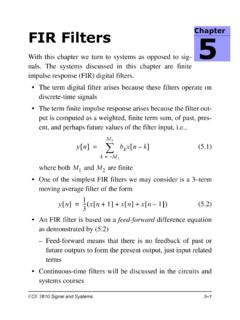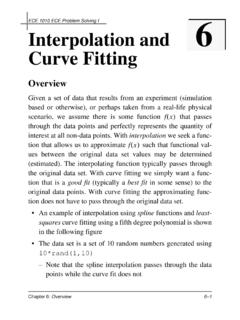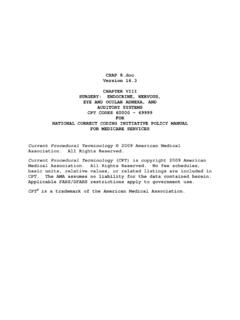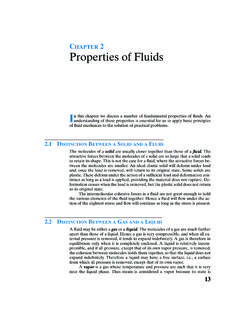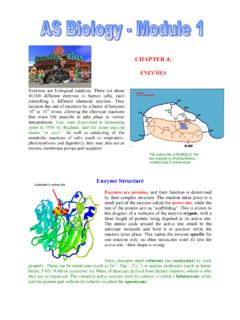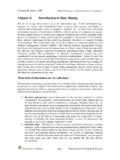Transcription of IIR Filters Chapter - University of Colorado Colorado …
1 ECE 2610 Signal and Systems8 1 IIR FiltersIn this Chapter we finally study the general infiniteimpulse response (IIR) difference equation that was men-tioned back in Chapter 5. The Filters will now include both feed-back and feedforward terms. The system function will be arational function where in general both the zeros and the polesare at nonzero locations in the General IIR Difference Equation The general IIR difference equation described in Chapter 5was of the form( ) In this Chapter the text rearranges this equation so that ison the left and all of the other terms are on the right( ) In so doing notice the sign change of the coefficients,and also we assume that The total coefficient count is , meaning that thismany multiplies are needed to compute each new output fromthe difference equationalynl l0=N bkxnk k0=M =yn yn alynl l1=N bkxnk k0=M +=al a01=NM1++Chapter8 Time-Domain ResponseECE 2610 Signals and Systems8 2 Block Diagram As a special case consider The above logically extends to any order This structure is known as Direct-Form ITime-Domain response To get started with IIR time-domain analysis we will considera first-order filter () with NM3==yn alynl l1=3 bkxnk k0=3 +=yn xn z1 z1 z1 z1 z1 z1 yn1 yn2 yn3 xn1 xn2 xn3 b0b1b2b3a1a2a3 Feed-forwardpartFeedbackpartDirect Form I StructureN1=M0=Time-Domain ResponseECE 2610 Signals and Systems8 3( )
2 impulse response of a First-Order IIR System The impulse response can be obtained by setting and insuring that the system is initially at rest Definition: Initial rest conditions for an IIR filter means that: (1) The input is zero prior to the start time , that is for (2) The output is zero prior to the start time, that is for We now proceed to find the impulse response of ( ) viadirect recursion of the difference equation In summary we have shown that the impulse response of a1st-order IIR filter is( )where the unit step has been utilized to make it clearthat the output is zero for yn a1yn1 b0xn +=xn n =n0xn 0=nn0 yn 0=nn0 y0 a1y1 b0 0 +b0==y1 a1y0 b0 1 +a1b0==y2 a1y1 b0 2 +a12b0== yn a1nb0n0 =000hn b0a1 nun =un n0 Time-Domain ResponseECE 2610 Signals and Systems8 4 Example.
3 First-Order IIR with The impulse response isLinearity and Time Invariance of IIR Filters Recall that in Chapter 5 the definitions of time invariance andlinearity were introduced and shown to hold for FIR Filters It can be shown that the general IIR difference equation alsoexhibits linearity and time invariance Using linearity and time invariance we can find the output ofthe first-order system to a linear combination of time shiftedimpulses( ) From the impulse response of ( )b01a1 = Order IIR a1 , b0 1 hn xn xk nk kN1=N2 =Time-Domain ResponseECE 2610 Signals and Systems8 5( )Example: , and Using the above result, it follows that Plotting this function results in Linearity and time-invariance can also be used to find theimpulse response of related IIR Filters , ,( ) We can view this as the superposition of an undelayed anddelayed input to the filter( )yn xk hnk kN1=N2 =xk b0a1 nk unk kN1=N2 =xn 2 n2 n4 = 2 n2 un2 n4 un4 =5101520n yn a1yn1 b0xn b1xn1 ++=yn a1yn1 xn +=Time-Domain ResponseECE 2610 Signals and Systems8 6 Based on this observation, the impulse response is( )Step response of a First-Order Recursive System The step response allows us to see how a filter (system)
4 Responds to an infinitely long input We now consider the step response of Via direct recursion of the difference equation The summary form indicates a finite geometric series, whichhas solution( )hn b0a1 nun b1a1 n1 un1 +=b0 n b0b1a11 + a1 nun1 +=yn a1yn1 b0xn +=y0 a1y1 b0u0 +b0==y1 a1y0 b0u1 +a1b0b0+==y2 a1y1 b0u2 +a1a1b0b0+ b0+== yn b01a1 a1n+++ b0a1kk0=n ==0rkk0=L 1rL1+ 1r ---------------------,r1 L1,+r = 1 =Time-Domain ResponseECE 2610 Signals and Systems8 7 Using ( ) and assuming that , the step response ofthe first-order filter is( ) Three conditions for exist1. When the term grows without bound as nbecomes large, resulting in an unstable condition2. When the term decays to zero as ,and we have a stable condition3. When we have the special case output of ( )where the output is of the form , which alsogrows without bound.
5 With the output alternatessign, hence we have a marginally stable conditionExample: and The step response of this filter isa11 yn b01a1n1+ 1a1 ---------------------un =a1a11 a1n1+a11 a1n1+n a11=b0n1+ a11 = 1==xn un =yn n1+ 1 -------------------------------un =Time-Domain ResponseECE 2610 Signals and Systems8 8 The step response can also be obtained by direct evaluationof the convolution sum( ) For the problem at hand( ) To evaluate this requires careful attention to details The product tells us how to set the sum limits yn xn *hn un *hn ==yn uk b0a1 nk unk k = =uk unk kkn0 00unk uk n0 nnSystem Function of an IIR FilterECE 2610 Signals and Systems8 9 The result is( )which is the same result obtained by the direct recursionSystem Function of an IIR Filter From our study of the z-transform we know that convolutionin the time (sequence)-domain corresponds to multiplicationin the z-domain For the case of IIR Filters will be a fully rational func-tion, meaning in general both poles and zeros (more than at) Begin by z-transforming both sides of the general IIR differ-ence equation using the delay propertyyn b0a1 nk k0=n un =b0a1 na1 k k0=n =b0a1 n11a1 n1+ 11a1 ------------------------------------=b01 a1 n1+ 1a1 -----------------------------=yn xn *hn =Xz Hz Yz =zHz z0=System Function of an IIR FilterECE 2610 Signals and Systems8 10( ) Form the ratio ( )
6 The coefficients of the numerator polynomial, denoted ,correspond to the feed-forward terms of the difference equa-tion The coefficients of the denominator polynomial, denoted, for correspond to the feedback terms of thedifference equation We have used various MATLAB functions that take as input band a coefficient vectors, , filter(b,a,..),freqz(b,a,..), and zplane(b,a) In terms of the general IIR system we now identify those vec-tors as( )Yz alzl Yz l1=N bkzk Xz k0=M += ZTynl ZTxnk Yz Xz Hz =Hz bkzk k0=M 1alzl l1=N ------------------------------b0b1z1 bMzM +++1a1z1 aNzN ---------------------------------------- --------------------==Bz Az zl l0 bb0b1 bM =a1a1a2 aN =System Function of an IIR FilterECE 2610 Signals and Systems8 11 The General First-Order Case As a special case consider , then( )Example: impulse response Using MATLAB Suppose that , , and >> n = 0:20;>> x = [1 zeros(1,20)]; % impulse sequence input>> y = filter([-3,2],[1 ],x);>> stem(n,y,'filled')>> axis([0 10.)]
7 6])>> grid>> ylabel(' impulse response h[n]')>> xlabel('Time Index (n)')NM1==Hz b0b1z1 +1a1z1 -------------------------= =b12=012345678910 3 2 1 response h[n]Time Index (n)System Function of an IIR FilterECE 2610 Signals and Systems8 12 Example: y = filter([1 1],[1 ],x) We wish to find the system function, impulse response , anddifference equation that corresponds to the given filter()expression By inspection The impulse response using page 8 5, eqns ( ) ( ) The difference equation isSystem Functions and Block-Diagram Structures We have already examined the Direct-Form I structure (p. 8 2) The Direct-Form I structure implements the feed-forwardterms first followed by the feedback terms We can view this as a cascade of two systems, which due tolinearity can also be written as( ) In the block diagram this is represented asHz 1z1 +1 ------------------------=hn n + nun1 +=yn xn xn1 ++=Hz Bz 1Az ----------- 1Az -----------Bz ==System Function of an IIR FilterECE 2610 Signals and Systems8 13yn xn z1 z1 z1 z1 z1 z1 wn1 wn2 wn3 b0b1b2b3a1a2a3wn Combine commondelay blocksz1 z1 z1 b0b1b2b3a1a2a3xn yn Direct-Form IIwn Az Bz Shown for NM3==System Function of an IIR FilterECE 2610 Signals and Systems8 14 The Direct-Form II structure uses fewer delay blocks thanDirect-Form IThe Transposed Structures A property of filter block diagrams is that When all of the arrows are reversed All branch points become summing nodes.
8 All summingnodes become branch points The input and output are interchanged The system function is unchangedb1b2b3z1 z1 z1 a1a2a3b0xn yn Transposed Direct-Form IIThe MATLAB function filter()implements thisblock diagramSystem Function of an IIR FilterECE 2610 Signals and Systems8 15 Relation to the impulse response From Chapter 7 we know that the impulse response and sys-tem function are related via the z-transform For IIR systems more work is required to obtain the z-trans-form Consider , where we have learnedthat the impulse response is From the definition of the z-transform,( ) The sum of ( ) is an infinite geometric series which ingeneral terms is Applying the sum formula to ( ) results in( ) The condition that tells us that the z-transformonly exists for these values of z The z-plane region is known as the region of convergence We have thus established the following z-transform relation-yn ayn1 xn +=hn anun =Hz anzn n0= az1 nn0= ==Srnn0= 11r -----------r1 ==Hz az1 nn0= 11az1 -------------------za ==za Poles and ZerosECE 2610 Signals and Systems8 16ship( ) We can use this result to find the z-transform of( )
9 Directly using just linearity and the delay property We will learn later that we can work this operation in reverse,and when combined with partial fraction expansion, we willbe able to find the inverse z-transform of almost any rationalPoles and Zeros Factoring the numerator denominator polynomials allows usto discover the poles and zeros of For the case of a first-order system only algebra is neededanun 11az1 ------------------- zhn b0a1 nun b1a1 n1 un1 +=Hz b011a1z1 ----------------------b1z1 11a1z1 ----------------------+=b0b1z1 +1a1z1 -------------------------=Hz Hz Hz b0b1z1 +1a1z1 -------------------------zz-- b0zb1+za1 --------------------b0zb1b0 +za1 -----------------------===Poles and ZerosECE 2610 Signals and Systems8 17 The single pole and zero are and Poles or Zeros at the Origin or Infinity For the general IIR filter/system the number of poles alwaysequals the number of zeros For FIR systems we saw that all of the poles were at It is also possible to have poles or zeros at Example.
10 Zero at Consider This system has a pole at and zero at sincep1a1=z1b1b0 =a1b1 b0---------z-Planez0=z =z =Hz 2z1 1 ---------------== =Hz z lim0=Poles and ZerosECE 2610 Signals and Systems8 18 Example: Pole at Consider This system has a pole at and a zero at Pole Locations and Stability We know that( ) We note that this system has a pole at and a zero at The impulse response decays to zero so long as ,which is equivalent to requiring that the pole lies inside theunit circle System Stability: Causal LTI IIR systems, initially at rest,are stable if all of the poles of the system function lie insidethe unit circleExample: Converting to positive powers of zz =Hz +z1 +==z = =hn anun =11az1 ------------------- Hz =zza=z0=a1 Hz 15z1 1 =Hz z5 ---------------------=Pole at z so stable=Poles and ZerosECE 2610 Signals and Systems8 19 Example.
